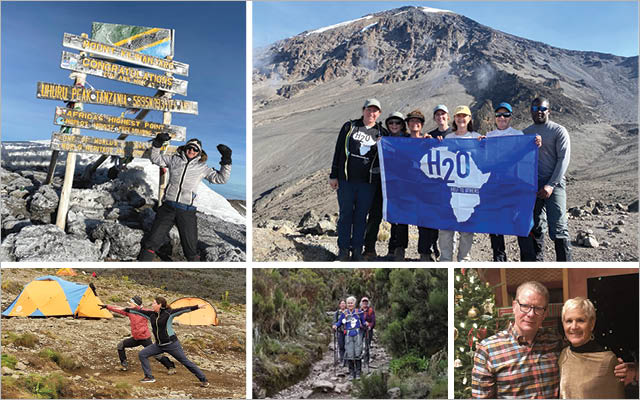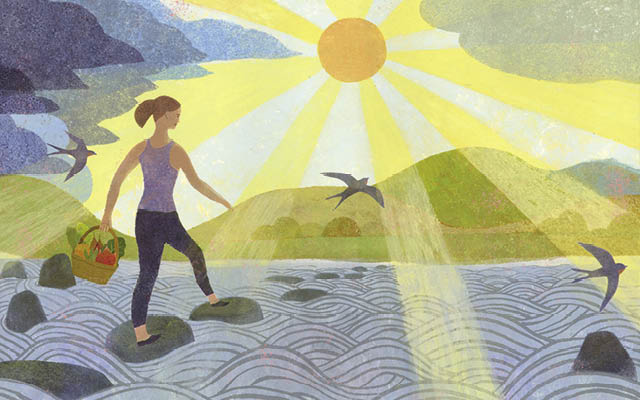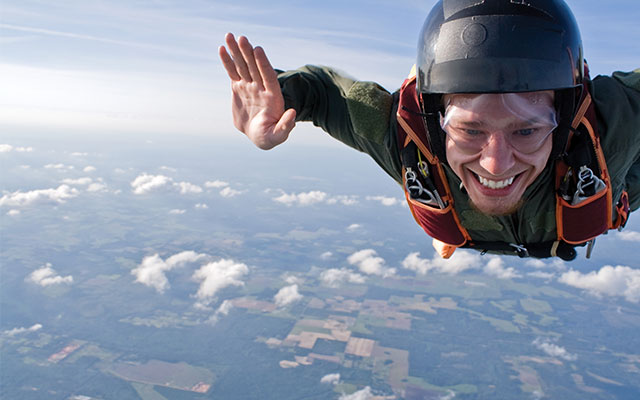On Feb. 22, 2020, I was four days into my ascent of Mount Kilimanjaro in Tanzania, Africa, the tallest free-standing mountain in the world, listening to the guide preview the next day’s portion of the climb. Barranco Wall, a section of the wall nicknamed the “kissing rock,” is an outcrop where climbers flatten their face to the rock wall to sidestep on a narrow ledge with a precipitous drop-off behind.
This was the section I’d feared most since committing to summit the dormant volcano a year earlier. Our guide offered an easier, alternate route for those who didn’t have the courage. Every rational cell in my being urged me to take the alternate route. But was my ego going to let me choose easy?
As a 64-year-old nurse practitioner, mother, and grandmother, I’m careful and consider risks, but I have never allowed fear to circumvent my spirit of adventure. I have finished six marathons and a half-Ironman triathlon. I know how to mentally get through a challenge.
This felt different. My fear of heights had never factored into my running or triathlons.
The following day, I fell in line behind the leader as we climbed up the side of the Barranco Wall. While I had summoned my courage, I still carried my doubts on whether or not to cross this dreaded passage or take the easier route. I gave my pack to another guide because I feared the weight would pull me over the ledge. That’s when I questioned why I was even doing this.
Following My Why
What kept me climbing was my work with H2O for Life, an organization my good friend Patty Hall started in 2007. Its purpose is to activate U.S. youth to help solve the global water crisis by raising awareness and funds to implement water sanitation and hygiene education programs for schools. Our partner NGOs (or nongovernmental organizations) leverage these funds to build simple wells or water catchment systems, sanitary toilets, and hand-washing stations at schools in need around the world.
When the project is completed, the teachers and students trade pictures and letters with those in the United States. This is the part I love — the student-to-student connections.
I’ve been a volunteer with H2O for Life for 10 years and board chair since 2018. The idea to climb Mount Kilimanjaro came to me while I was traveling to Uganda in 2019 as part of Vision, a student-led global community-building program at the University of St. Thomas in St. Paul, Minn., where I work as a part-time nurse practitioner in the student health center.
The students and I were moved by the many challenges faced by the NGOs we visited in remote areas of the country. One of our leaders shared how he had climbed Kilimanjaro to raise funds for an NGO, and an idea was born.
Climbing Kilimanjaro seemed like an exciting, challenging, and meaningful opportunity to raise funds for H2O for Life. I started looking into it right away, and I found out how daunting this adventure would be. In addition to my fear of heights, I was frightened by the risk of high-altitude sickness, which can affect the fittest of people.
Even though Kilimanjaro is considered one of the easiest of the Seven Summits (the highest peaks on the seven continents) and doesn’t require technical skill, I worried that my body couldn’t withstand the challenge.
Overcoming Setbacks
I ran two marathons in my 20s, and four after turning 50, completing my sixth marathon for my 60th birthday. At 58, I completed a half-Ironman — all while living with early-onset degenerative-disc disease in my back and recovering from cervical-spine surgery in 2015.
So here I was going into this challenge with a bad neck and back, carrying a heavy pack, and sleeping on the ground in a tent. This weighed on me, but I committed to make the climb and started fundraising.
Friends and family from all walks of my life sent donations. I quickly raised over $12,000 — more than double my goal. I now had almost 100 people counting on me to get to the top.
In September 2019, a few of my climbing partners and I started working with personal trainers at Life Time in White Bear Lake, Minn. Our trainers researched strength-specific workouts and challenges on the indoor stairclimber. We found the hilliest locations in our area to hike with backpacks weighing 15 to 20 pounds, and continued to cross-train with cycling, swimming, and yoga.
I had to develop a mental picture of success. I’d used positive self-talk and mantras to get through marathons and triathlons in the past. Mentally training myself to go the distance and overcome the voices in my head telling me to stop was just as important as physical training.
Being Fierce
Right before I boarded the plane for Tanzania, my husband, John, gave me a bracelet that said “Be Fierce.” I wore it every day, and it became the mantra I repeated as I stepped hand over foot along the short but interminable switchbacks of the Barranco Wall.
Throughout the climb, whenever I felt overwhelmed, the guides were there to help. On the wall I got to a point when I could not reach or step far enough to grab the hand of the lead guide, Felix. Another guide, Johnny, positioned himself between us over the abyss. He grabbed my waist and swept me sideways to safety.
Once on the other side, they let me know I had just passed Kissing Rock — 365 days of worry was over. I sat down and cried. As it turned out, the guides had lied; there was no alternate route. It was the best lie ever told, and my mantra was true: I am fierce.
Two days later, on Feb. 24, we made the final ascent. Wind whipped through our tents, and sleet fell as we set off at midnight. All I could see was the light from the headlamp hitting the feet in front of me. The short, steep switchbacks eventually flattened out into a snowfield, and the sun began to shine below me.
The air was thin; I couldn’t have picked up the pace, but I wasn’t gasping for air. A couple of my companions threw up. Another was disoriented. Another needed a push.
Then we came over a mound and saw our finish line. We reached the summit. I felt as if I were looking down at Earth from outer space.
The awe I felt from the view was only elevated by the achievement. As I looked out at how high I had climbed, the accomplishment included the measure of how many lives would be changed with clean water.
My quest for new physical challenges will continue, as will my work for H2O for Life. I’ll try to top these fundraising efforts — I just won’t go higher than 19,341 feet!
Kate’s Top 3 Success Strategies
1. Be brave and sign up. “You will not know until you try,” Kate says. The first act of courage is committing. Just say — out loud — “I’m going to go for it.”
2. Break big challenges down into small steps. “When something you want to do seems overwhelming, take it piece by piece. As they say on the mountain, using a Swahili term: ‘Polepole, slowly, slowly, gets you to the top.’”
3. Trust yourself to complete the mission. “If you can do the training, you can do the race,” Kate says. Preparing for an event is notoriously harder than the event itself, which can be applied to many aspects of life.
Tell Us Your Story: Have a transformational healthy-living tale of your own? Share it with us at ELmag.com/myturnaround.
This originally appeared as “Climbing for a Cause” in the October 2020 print issue of Experience Life.




This Post Has 0 Comments